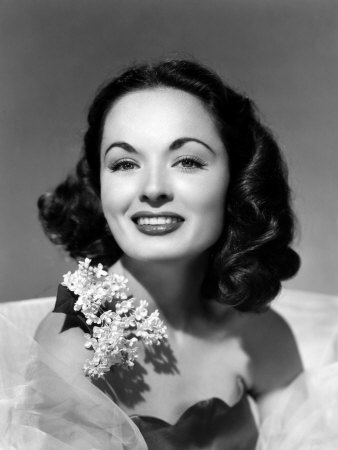pikespeakmtnman
Pre-takeoff checklist
On facebook I am a part of a group called “Old pics of Colorado Springs” and Colorado Springs has a extensive aviation history.
Our municipal airport was built in the 1920’s, we are, or were, home to (among others) the Air Force Academy, Peterson AFB, the former Ent AFB and Alexander Aircraft manufacturing.
I’ve decided to post some of the pictures here. The information included with the photos is from FB, so accuracy (such as dates, specific locations and other details) may not be 100% correct.
I’ve tried to group the photos logically such as Peterson Field, City Airport, Alexander, and so on.
--------------
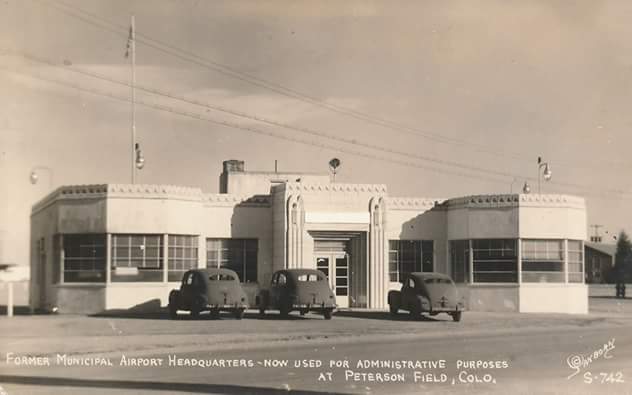
PETERSON AFB 75TH ANNIVERSARY: The first air passenger terminal for the city of Colorado Springs was built at the Colorado Springs Municipal Airport by Continental Air Lines in 1941. Cost of construction was around $20,000.
Following the activation of Colorado Springs Army Air Base at the airport site in April 1942 (75 years ago!), the terminal served as the first base headquarters during base construction. It also housed the base weather station. After construction of the base was complete in 1943, the terminal housed the Special Services (morale and recreation) officer, the American Red Cross and the Army Emergency Relief Fund office.
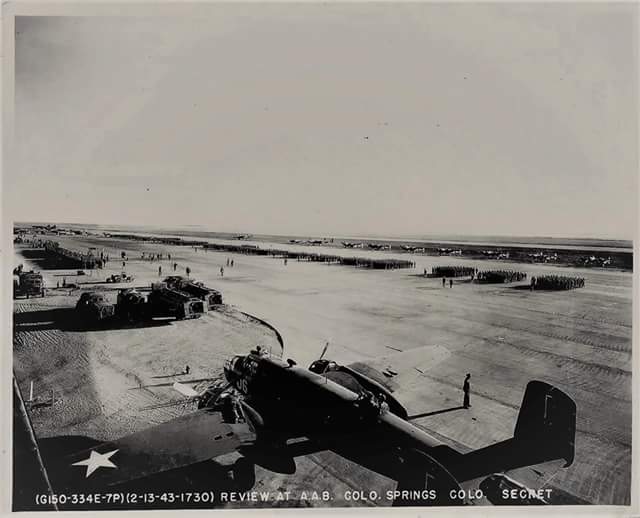
THROWBACK THURSDAY! Today's image was sent to us recently by one of our friends and dated February 1943. It shows a formation of Army Air Forces soldiers participating in a review of troops at Peterson Army Air Base. We think this may be a "graduation" review for a newly formed photographic reconnaissance group that has just completed its operational training and preparing for departure to its assigned combat area.
Note the photo reconnaissance aircraft lined up behind the soldiers. These are photo recon versions of the Lockheed P-38 "Lightning" fighter, designated the F-4A. ("F" stood for "Foto" at that time!) The aircraft in the foreground is a North American B-25 "Mitchell" medium bomber, or possibly the photo reconnaissance version of the B-25, designated the F-10.
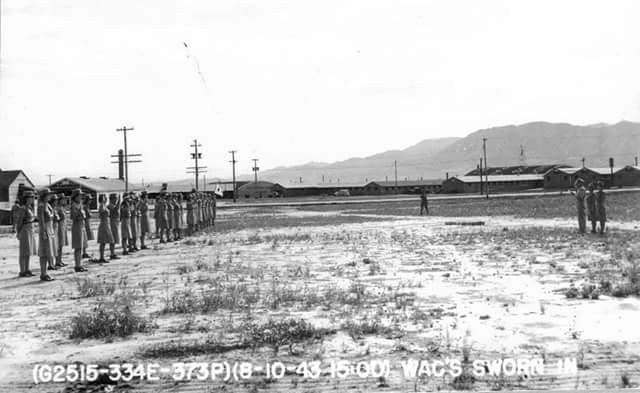
WOMEN'S HISTORY MONTH: This image from August 1943 shows Women's Army Corps (WAC) soldiers being sworn into service at Peterson Field. The curved-roof structures in the background are the City Hangar (at right, built in 1928) and the Broadmoor Hangar (at left, built in 1930). These two hangars were part of the Colorado Springs Municipal Airport, before the establishment of Colorado Springs Army Air Base in April 1942. Today these buildings are part of the Peterson Air and Space Museum.
A WAC detachment was assigned to Peterson Field in June 1943. These female soldiers performed numerous duties at the base, including administrative and communications work, and supply and transportation. They also worked at Second Air Force headquarters, located at what is today the US Olympic Training Center near downtown Colorado Springs. In 1944, a group of enlisted WAC communications specialists became flight qualified and were radio operators on cargo aircraft flying missions from Peterson Field!
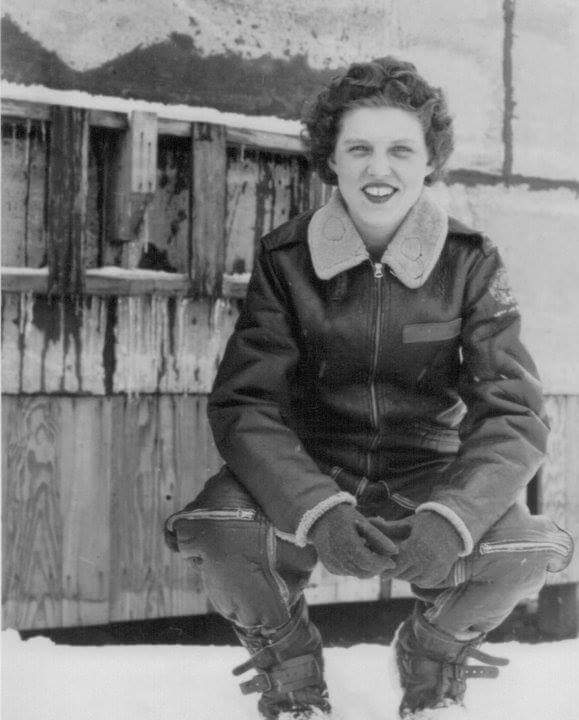
Women’s Army Corps soldier Sergeant Gladys Gabler shows off her winter flying gear. Sergeant Gabler was a radio operator with the 202nd Army Air Forces Base Unit at Peterson Field in 1944-1945. The 202nd flew cargo and passenger missions from Peterson to other Second Air Force bases in the western US using Douglas C-47’s and Boeing B-17’s converted to cargo aircraft.
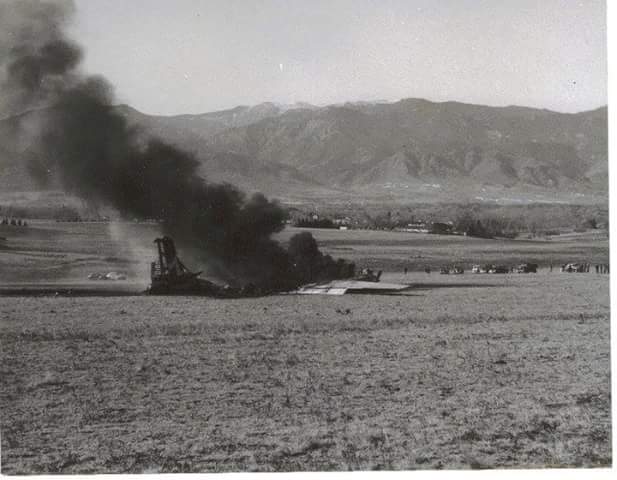
On November 5th, 1948, a US Air Force Boeing B-29 "Superfortress" heavy bomber assigned to the 301st Bombardment Group took off from Peterson Field enroute to its home base at Smoky Hill Air Force Base, Kansas.
Just after take-off, the aircraft lost #3 and #4 engines. The pilot decided he could not do a go-around and land back at Peterson Field, so he opted to put the aircraft down in a vacant field northeast of Patty Jewett Golf Course (roughly the intersection of Union Blvd and Constitution Ave today). All 10 crewmembers survived the crash with minor injuries. The aircraft caught fire and was a total loss.
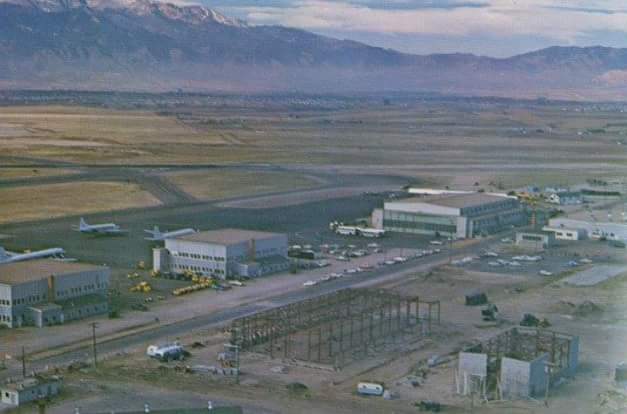
New construction at Peterson Field, late 1960's. The hangar at right is Hangar 140 (commonly referred to as Hangar 1), in the center is Hangar 133, and at left, Hangar 130. All these World War II-era hangars are still in use today. The buildings under construction are used today as maintenance shops for the Air Force Reserve's 302nd Airlift Wing, operating C-130 Hercules cargo planes.
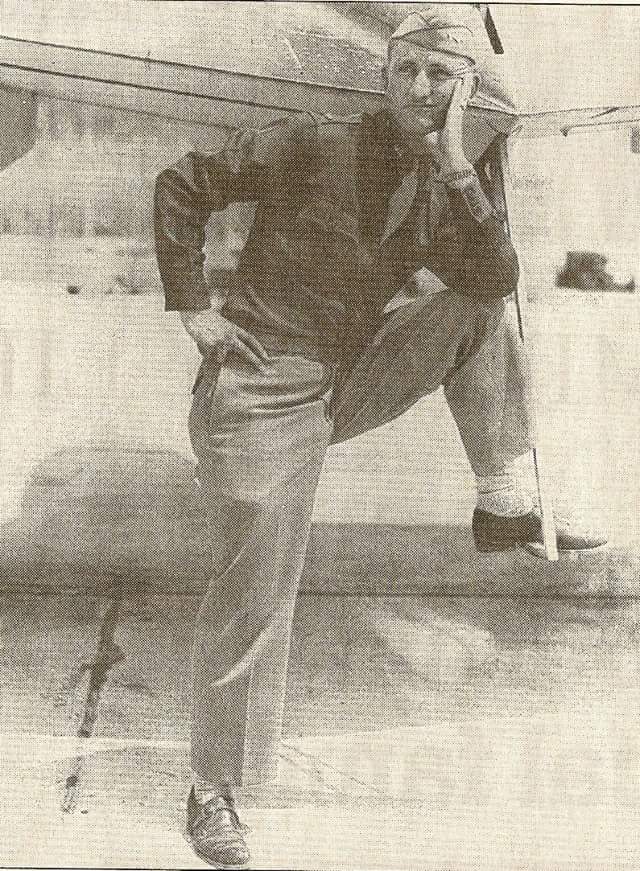
The base was renamed for US Army Air Forces First Lieutenant Edward J. Peterson, a native of Englewood, Colorado, who died from injuries received in a plane crash at the base on August 9th, 1942. Lt. Peterson was the first Colorado native to lose his life in the line of duty at the base, which was established in April 1942.
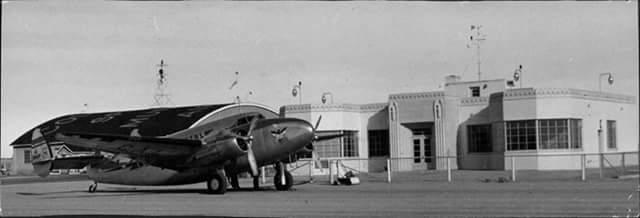
The very first passenger terminal at the Colorado Springs Municipal Airport, 1942. Built by Continental Airlines (note the Continental logo on the nose of the aircraft) in 1941 at a cost of just under $20,000. The architectural design style is Art Deco Revival, which was popular for aviation-related structures back in the day. In background left is the City Hangar, which was the first permanent structure at the Airport and built in 1928.
The newly-constructed Colorado Springs Municipal Airport passenger terminal in early 1942. It was constructed by Continental Airlines in 1940-1941 for a cost of not quite $20,000. Art Deco Revival-style architecture, with stylized eagles atop either side of the front entrance. You walked out the front entrance, went through a small gate, and boarded your airplane! No metal detectors or full-body scanners, no TSA pat-downs, a much simpler time for air travel!
The City Hangar is at left, behind the Continental Airlines Lockheed Model 14 Electra passenger plane. You could hangar your private aircraft in the hangar for 2 dollars a day.
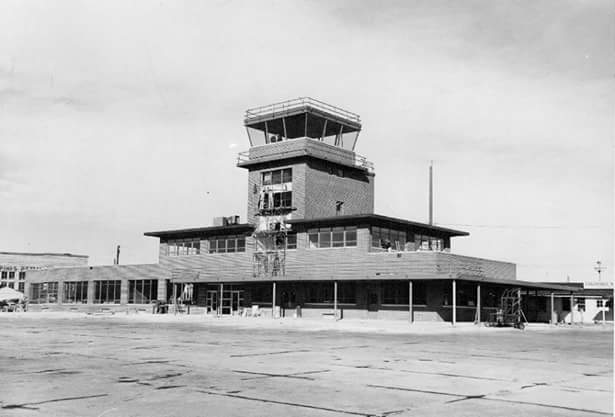
In 1954, the City of Colorado Springs completed a new Municipal Airport passenger terminal and control tower, located on Peterson Field. This terminal was used for civilian passenger traffic until construction of a new airport terminal on the west side of the shared runways (across from Peterson) in 1966.
This building remains in use today as the military passenger terminal and Base Operations for Peterson Air Force Base.
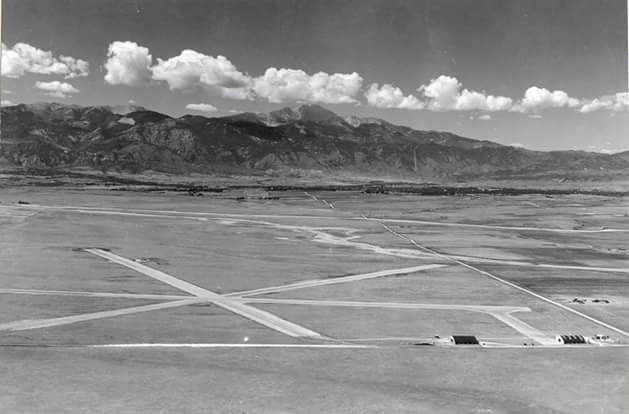
The Colorado Springs Municipal Airport, seen here in 1940, was selected as the site for Army Air Forces training site in April 1942. The airport had been constructed in the 1920’s. The base is today’s Peterson Air Force Base, and the original airport buildings seen in this photo are part of the Peterson Air and Space Museum.
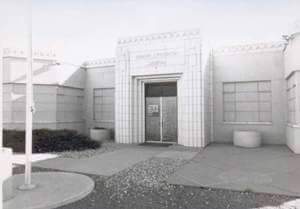
Colorado Springs ~ Airport ~ 1955
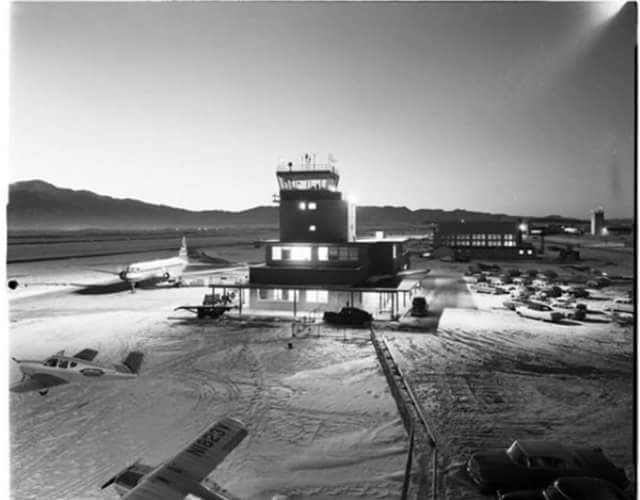
Colorado Springs Airport February 14th ♡1957
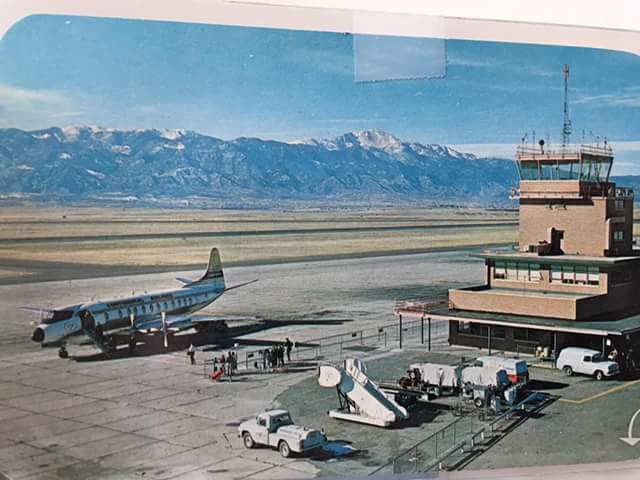
Colorado Springs airport. Judging by the plane and cars, it's gotta be around 1960. Can't believe all that open land!
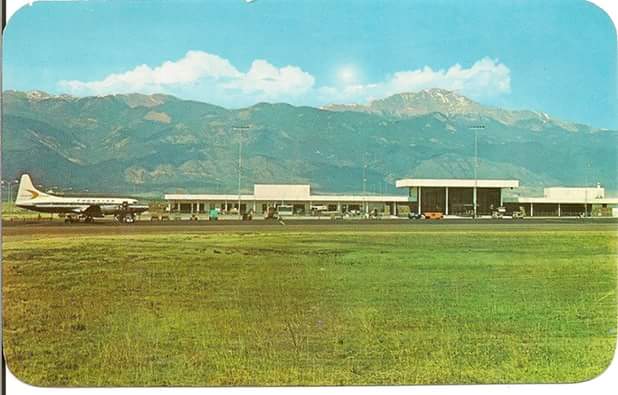
Postcard: Municipal Airport, Colorado Springs, year unknown.
Our municipal airport was built in the 1920’s, we are, or were, home to (among others) the Air Force Academy, Peterson AFB, the former Ent AFB and Alexander Aircraft manufacturing.
I’ve decided to post some of the pictures here. The information included with the photos is from FB, so accuracy (such as dates, specific locations and other details) may not be 100% correct.
I’ve tried to group the photos logically such as Peterson Field, City Airport, Alexander, and so on.
--------------
PETERSON AFB 75TH ANNIVERSARY: The first air passenger terminal for the city of Colorado Springs was built at the Colorado Springs Municipal Airport by Continental Air Lines in 1941. Cost of construction was around $20,000.
Following the activation of Colorado Springs Army Air Base at the airport site in April 1942 (75 years ago!), the terminal served as the first base headquarters during base construction. It also housed the base weather station. After construction of the base was complete in 1943, the terminal housed the Special Services (morale and recreation) officer, the American Red Cross and the Army Emergency Relief Fund office.
THROWBACK THURSDAY! Today's image was sent to us recently by one of our friends and dated February 1943. It shows a formation of Army Air Forces soldiers participating in a review of troops at Peterson Army Air Base. We think this may be a "graduation" review for a newly formed photographic reconnaissance group that has just completed its operational training and preparing for departure to its assigned combat area.
Note the photo reconnaissance aircraft lined up behind the soldiers. These are photo recon versions of the Lockheed P-38 "Lightning" fighter, designated the F-4A. ("F" stood for "Foto" at that time!) The aircraft in the foreground is a North American B-25 "Mitchell" medium bomber, or possibly the photo reconnaissance version of the B-25, designated the F-10.
WOMEN'S HISTORY MONTH: This image from August 1943 shows Women's Army Corps (WAC) soldiers being sworn into service at Peterson Field. The curved-roof structures in the background are the City Hangar (at right, built in 1928) and the Broadmoor Hangar (at left, built in 1930). These two hangars were part of the Colorado Springs Municipal Airport, before the establishment of Colorado Springs Army Air Base in April 1942. Today these buildings are part of the Peterson Air and Space Museum.
A WAC detachment was assigned to Peterson Field in June 1943. These female soldiers performed numerous duties at the base, including administrative and communications work, and supply and transportation. They also worked at Second Air Force headquarters, located at what is today the US Olympic Training Center near downtown Colorado Springs. In 1944, a group of enlisted WAC communications specialists became flight qualified and were radio operators on cargo aircraft flying missions from Peterson Field!
Women’s Army Corps soldier Sergeant Gladys Gabler shows off her winter flying gear. Sergeant Gabler was a radio operator with the 202nd Army Air Forces Base Unit at Peterson Field in 1944-1945. The 202nd flew cargo and passenger missions from Peterson to other Second Air Force bases in the western US using Douglas C-47’s and Boeing B-17’s converted to cargo aircraft.
On November 5th, 1948, a US Air Force Boeing B-29 "Superfortress" heavy bomber assigned to the 301st Bombardment Group took off from Peterson Field enroute to its home base at Smoky Hill Air Force Base, Kansas.
Just after take-off, the aircraft lost #3 and #4 engines. The pilot decided he could not do a go-around and land back at Peterson Field, so he opted to put the aircraft down in a vacant field northeast of Patty Jewett Golf Course (roughly the intersection of Union Blvd and Constitution Ave today). All 10 crewmembers survived the crash with minor injuries. The aircraft caught fire and was a total loss.
New construction at Peterson Field, late 1960's. The hangar at right is Hangar 140 (commonly referred to as Hangar 1), in the center is Hangar 133, and at left, Hangar 130. All these World War II-era hangars are still in use today. The buildings under construction are used today as maintenance shops for the Air Force Reserve's 302nd Airlift Wing, operating C-130 Hercules cargo planes.
The base was renamed for US Army Air Forces First Lieutenant Edward J. Peterson, a native of Englewood, Colorado, who died from injuries received in a plane crash at the base on August 9th, 1942. Lt. Peterson was the first Colorado native to lose his life in the line of duty at the base, which was established in April 1942.
The very first passenger terminal at the Colorado Springs Municipal Airport, 1942. Built by Continental Airlines (note the Continental logo on the nose of the aircraft) in 1941 at a cost of just under $20,000. The architectural design style is Art Deco Revival, which was popular for aviation-related structures back in the day. In background left is the City Hangar, which was the first permanent structure at the Airport and built in 1928.
The newly-constructed Colorado Springs Municipal Airport passenger terminal in early 1942. It was constructed by Continental Airlines in 1940-1941 for a cost of not quite $20,000. Art Deco Revival-style architecture, with stylized eagles atop either side of the front entrance. You walked out the front entrance, went through a small gate, and boarded your airplane! No metal detectors or full-body scanners, no TSA pat-downs, a much simpler time for air travel!
The City Hangar is at left, behind the Continental Airlines Lockheed Model 14 Electra passenger plane. You could hangar your private aircraft in the hangar for 2 dollars a day.
In 1954, the City of Colorado Springs completed a new Municipal Airport passenger terminal and control tower, located on Peterson Field. This terminal was used for civilian passenger traffic until construction of a new airport terminal on the west side of the shared runways (across from Peterson) in 1966.
This building remains in use today as the military passenger terminal and Base Operations for Peterson Air Force Base.
The Colorado Springs Municipal Airport, seen here in 1940, was selected as the site for Army Air Forces training site in April 1942. The airport had been constructed in the 1920’s. The base is today’s Peterson Air Force Base, and the original airport buildings seen in this photo are part of the Peterson Air and Space Museum.
Colorado Springs ~ Airport ~ 1955
Colorado Springs Airport February 14th ♡1957
Colorado Springs airport. Judging by the plane and cars, it's gotta be around 1960. Can't believe all that open land!
Postcard: Municipal Airport, Colorado Springs, year unknown.

